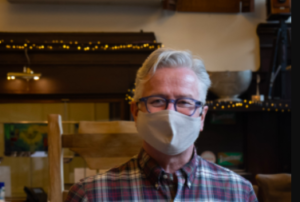Seumas MacInnes who has run the Cafe Gandolfi at the heart of Glasgow’s Merchant City for 40 years is getting ready to reopen the iconic restaurant on April 26 after what he describes as the toughest year of his life. But now he is looking forward to what he believes will be the best years ever for the City Centre. “A hard winter often leads to a lovely spring and I think this area is about to blossom in a way we have never seen it before. It has huge potential and it won’t take much for it to become one of the best places to live in Europe.”

Seumas MacInnes
Although the area around Glasgow Cross, the oldest part of Glasgow was once the most densely populated in Europe, the population fell last century and is still low in comparison to other former industrial cities such as Liverpool or Manchester, according to Glasgow City Council Living Strategy.
Bringing the area back to life after the pandemic is likely to mean changing the mix of office and shopping towards more residential provision. The vision for the area involves doubling the number of people living in the city centre from 20,000 to 40,000 by 2035, making more use of vacant property and upper floors.
The area is lacking in green space and there is a local campaign to turn Ingram St car park, which features a mural commissioned for the Commonwealth Games, into a park. Nearby award-winning Strathclyde University has temporarily pedestrianised streets during the pandemic and hopes to make that permanent. The City plan identifies the Rottenrow area around the campus as “the Learning Quarter” and regards it and the Merchant City as the most appropriate for increased housing.
At the Gandolfi, Seumas was in the vanguard of the area’s restoration in 1983 when he took over the place from fellow Hebridean and art school graduate Ian Mackenzie. It was Ian who gave the legendary Tim Stead his first major commission, to make the restaurant’s beautiful wooden furniture, in 1979 when he opened the place, naming it after a camera.
Since then, the area has changed a lot, acquiring the Old Fruitmarket concert hall, Merchant Square and acres of designer shops. “It was very different in those days – the streets were all dark and empty in the evenings. It was industrial and run-down. There were leather works and other factories, gap sites, and empty buildings.”
Son of the famous Gaelic singer Flora MacNeil from the isle of Barra, Seumas was introduced to the world of hospitality by neighbours. “I was one of five siblings. We grew up on the southside of Glasgow where we had some neighbours who were older and didn’t have children. They would take my older sister and me out for lunch. I loved the drama of eating in a restaurant, the theatre of it. For me, it was just like going into a different world.”
The island connection is strong at the Gandolfi and there have been many Hebrideans among the restaurant’s staff over the years. It is also a family business – Seumas’ twin sons are also employees – Donald is the general manager and Alasdair is a chef.
“The last year has been very tough. The toughest in my life I was worried we were going to lose everything we have worked for over the years, and that we would let a lot of people down.” During the first lockdown, Seumas would rise and dress for work as usual at 7am and fret, wondering what to do with himself. He took to going for long walks, and then started baking, leaving small gifts for shielding neighbours on their doorsteps. When the church was open, he would often seek refuge in there to pray and think.
The Gandolfi’s sister restaurant Gandolfi Fish won’t be reopening – it went into receivership. The family home was sold and Seumas and his wife Donalda MacKinnon, former head of Gaelic programming for BBC Scotland, moved temporarily into a rental flat. “These weren’t really choices. I just had to make some hard decisions to save the business.”
The periods of opening up and locking down, sometimes at short notice, were difficult too. “We have had to learn to manage our supply chains much more carefully. The first time we had fridges full of food. We put it in the freezer – but it was months before we opened again and we had to throw a lot of it away.” On one other lockdown, a load of fish had just been delivered – so Seumas made Cullen Skink for the local soup kitchen. He is very aware that many people have experienced even tougher times.
“Like a lot of businesses, we have had to take on debt to get through. But we have survived. Now we are just excited and delighted to welcome everyone back.”
